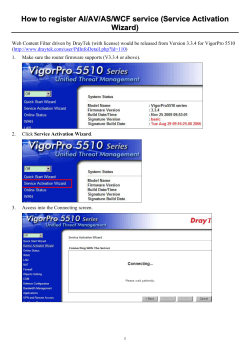
Western Governors University Tennessee Overview
Western Governors University Tennessee Overview 2014 Report Card on the Effectiveness of Teacher Training Programs Western Governors University Tennessee is a nonprofit, online university created to expand access to higher education for Tennessee residents. WGU Tennessee was established by the state of Tennessee through a partnership with nationally recognized Western Governors University. WGU Tennessee teacher degree programs are approved by the National Council for Accreditation of Teacher Education. Institution Highlights: • • • • • WGU Tennessee had 36 program completers in the 2012-2013 cohort and a 96 percent pass rate on the Praxis II Principles of Learning and Teaching examination. WGU Tennessee program completers perform at the same level as teachers statewide in 4th8th grade TCAP composite and math. Program completers from WGU Tennessee tend to be less effective than teachers statewide in high school End of Course exam composite. Program completers from WGU Tennessee tend to be less effective than other beginning teachers in high school End of Course exam composite. WGU Tennessee has a higher numbers of completers in the least effective quintile as compared to all teachers’ performance distributions across the state in high school End of Course exam composite. Western Governors University Tennessee Teacher Education Program Information Location: Franklin, TN Institution Type: Accreditation: Private/Nonprofit Online NCATE Top Endorsement Areas: Elementary K-6 (17 completers) 2012-2013 Program Completers Total Completers Male Female In-State Out-of-State Apprentice License Transitional License Completers Statewide 36 11% 89% 100% 36 >1% Academic Information Average All Completers Average Final GPA Major GPA High School GPA ACT Composite ACT Reading ACT Science ACT English ACT Math SAT Cumulative SAT Math SAT Verbal GRE Composite GRE Math GRE Verbal MAT Score N Range All Completers Average Apprentice Average N Average Transitional Average N State Average All Completers Average N 3.56 4258 3.40 2240 3.58 23.1 24.4 22.5 24.1 21.8 1110 549 557 1034 549 480 399 *Grade point averages are not available for WGU TN completers as courses are taken on a pass/fail basis. 1932 2406 2212 2181 2222 2220 294 283 282 228 239 240 275 WGU Tennessee 2014 Apprentice and Transitional Completers Teacher preparation program completers generally receive one of two types of initial license: Apprentice or Transitional. The Apprentice license is a full license, valid for five years, and renewable. The Transitional license is not a full teaching license; it is issued at the request of a superintendent/director of schools for a teacher who will be employed while completing licensure requirements. The license is issued for one school year at a time and may only be renewed two times for a maximum of three years. To receive either an Apprentice or Transitional license, an individual must hold a bachelor’s degree from a regionally accredited university and have demonstrated competency in the subject matter for which the candidate is seeking licensure. Transitional license candidates must hold a Bachelor’s degree, though the degree does not have to be conferred by the teacher training program. Academic Credential Completers Most Frequent Academic Major Bachelor’s Degree & License 30 Education, General Master’s Degree & License 6 Elementary Education & Teaching License Only Licensure Assessments Candidates for a Tennessee teaching license are required by training programs to demonstrate basic academic competencies. Candidates generally fulfill this requirement through standardized test scores. The most common standardized tests utilized are the ACT/SAT or the Core Academic Skills for Educators (Core) Reading, Writing, and Math assessment. In addition, Tennessee requires all teacher candidates seeking licensure take the Praxis II Principles of Learning and Teaching (PLT) exam and specific content area exams. Tennessee determines the qualifying score necessary to pass the Core Academic Skills for Educators and Praxis II assessments. Note: The pass rate is not provided if there were less than 5 test takers. Principles of Learning and Teaching WGU TN Completers • Apprentice License Completers • Transitional License Completers Number Taken 27 27 0 Number Passed 26 26 0 Pass Rate 96% 96% - Placement and Retention Data Data reflect the placement and retention rates of graduates for each cohort year listed. These data are based on the program completers in the Personnel Information Reporting System (PIRS). The years refer to the number of years since the completers have graduated and been eligible to teach. Therefore, these data help to inform the rate at which an institution’s graduates enter and remain in the teaching field in Tennessee public schools. The number teaching 3 out of 4 years is included to account for the teachers who may leave the profession for a year but do return (e.g. for maternity leave or FMLA). Cohort Year Number of Teaching Teaching Teaching Teaching 3 out Completers in Year 1 in Year 2 in Year 3 of 4 Years 2009-2010 NA 2010-2011 NA 2011-2012 NA 2012-2013 36 50.0% WGU Tennessee 2014 Statewide Distribution of Completers The distribution of completers from the 2012-2013 cohort across the state in the 2013-2014 school year in Tennessee public schools. County Anderson Blount Coffee Hamblen Hamilton Hardeman Knox Teachers 1 1 1 1 1 1 2 County Maury McMinn Montgomery Sequatchie Shelby Washington Williamson Teachers 1 2 2 2 1 1 1 WGU Tennessee 2014 Tennessee Value Added Assessment System (TVAAS) Analysis TVAAS analysis compares the effectiveness of a program’s beginning completers (individuals with 1-3 years of experience) in terms of contribution to student achievement growth to other groups of teachers in the state. Analysis is based on one year estimates of t-value of teacher effects in the 2013-2014 school year. TVAAS Statewide Teacher Comparison: The average effectiveness of beginning teachers who completed a training program at this institution as compared to the average effectiveness of teachers statewide in terms of contribution to student achievement growth. TVAAS Program Comparison: The average effectiveness of beginning teachers who completed a program at this institution as compared to the mean of the average effectiveness for beginning teachers from all teacher training programs in Tennessee in terms of contribution to student achievement growth. Apprentice License Teachers Subject TCAP Composite (grades 4-8) o Math EOC Composite (High School) Statewide Comparison - Program Comparison Teachers 5 5 5 - Programs Statewide 30 28 28 Transitional License Teacher Western Governors University Tennessee does not have completers teaching on a transitional license; therefore, no TVAAS analysis is available. Apprentice and Transitional License Teachers Subject TCAP Composite (grades 4-8) o Math EOC Composite (High School) Statewide Comparison - – represents a statistically significant negative effect Program Comparison - Teachers 5 5 5 Programs Statewide 34 31 32 + represents a statistically significant positive effect WGU Tennessee 2014 Statewide Distribution: The percentage of beginning teachers (1-3 years of experience) from this teacher training program who fall into either the lowest or highest effectiveness quintile. Quintiles are based upon the statewide distribution of the t-value of teacher effects in the 2013-2014 school year. Apprentice License Teachers Subject TCAP Composite (grades 4-8) o Math EOC Composite (High School) Below 20th Percentile 20.0% 20.0% 60.0% Statistically Significant - Above 80th Percentile 0.0% 0.0% 0.0% Statistically Significant Teachers 5 5 5 Transitional License Teachers Western Governors University Tennessee does not have completers teaching on a transitional license; therefore, no TVAAS analysis is available. Apprentice and Transitional License Teachers Subject TCAP Composite (grades 4-8) o Math EOC Composite (High School) Below 20th Percentile 20.0% 20.0% 60.0% – represents a statistically significant negative effect Statistically Significant - Above 80th Percentile 0.0% 0.0% 0.0% Statistically Significant Teachers 5 5 5 + represents a statistically significant positive effect
© Copyright 2025









